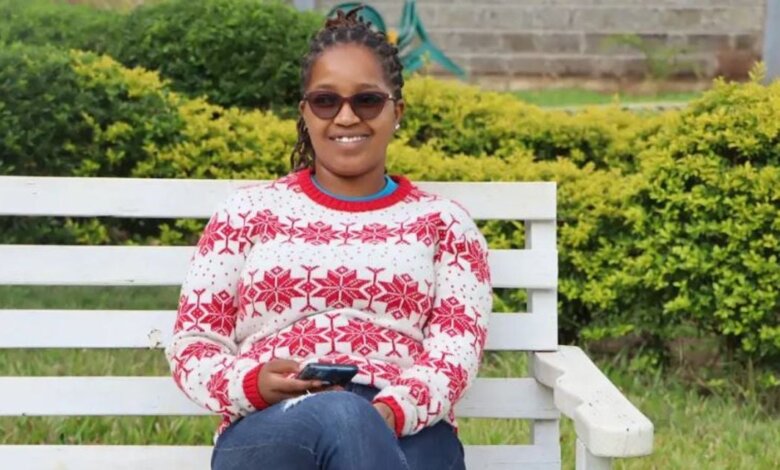What life is for Kenyans with rare ‘mind blindness’

Close your eyes. Then, picture a banana. You see it, right? Now, picture the face of your father or mother. I bet you can see it, too. Well, as many people may be able to visualise images in their minds, one per cent globally cannot. This is called aphantasia. Simply put, it’s blindness of the mind.
Lynn Wanjiru Kihara, 28, a nurse from Murang’a County, in Kenya was shocked a few months ago to find out that she was among the few people who could not visualise things in their minds.
“I first got to know of aphantasia five months ago after a cognitive neurologist carried out a series of tests during a medical appointment,” she narrates.
During the tests, the neurologist asked her to describe her father. She couldn’t.
“I had to fish out a photo from my phone to answer his question. All my life, it had never occurred to me that human beings visualise things in their minds. I was shocked to learn about it from him because I always thought everyone functions like I do,” Ms Kihara said in an interview with the Nation.
Symon Kariuki, a cognitive neurologist and researcher at the Kemri Wellcome Trust in Kilifi, who co-leads the neuroscience research programme, said aphantasia is not a disorder but a different way of viewing the world. He explains that imagination is how your brain “simulates” something based on knowledge or past events.
Think of visual imagination like a TV. Some people have black-and-white TVs. Others have colour TVs. An incredibly vivid imagination is like having an ultra-high-definition digital TV. But for those living with aphantasia, it’s like your mind not having a TV because it wouldn’t use it. And because your ‘mind’s eye’ doesn’t work, your imagination adapts and kicks in using other ways.
But where did the term ‘aphantasia’ come from?
In 2015, Prof Adam Zeman of the University of Exeter first coined the term aphantasia to describe the difficulties human beings who can’t visualise experience. Since then, tens of thousands of people worldwide have identified with the description. Prof Zeman also established that aphantasia is not a single entity but has subtypes.
It is thought to affect around one per cent of the global population, while three per cent are hyperphantasic. These figures rise to around five and ten per cent with more generous criteria for inclusion. Prof Zeman explained that both aphantasia and hyperphantasia often run in families, hinting at the possibility of a genetic basis.
“Despite the profound contrast in subjective experience between aphantasia and hyperphantasia, effects on everyday functioning are subtle — lack of imagery does not imply lack of imagination. Indeed, the consensus among researchers is that neither aphantasia nor hyperphantasia is a disorder, ” Prof Zeman noted in his findings.
He added that coining the term ‘aphantasia’ has unexpectedly opened a window on a neglected aspect of human experience.
What really causes it?
Experts do not know yet, though they have classified them as congenital or acquired aphantasia. Congenital aphantasia may be genetic as people with blindness of the mind are much more likely to have a close biological family member who also has it, so it may run in families.
According to Mr Kariuki, it may also be a form of neurodiversity. Being neurodivergent means your brain develops or works differently from the brains of people whose brains develop or work as expected (known as neurotypical). Some — but not all — cases of acquired aphantasia have causes experts can find.
In rare cases, it can be a symptom of injuries or illnesses that affect the brain. Aphantasia can happen due to damage to certain areas of the brain, especially the occipital lobe. The neuroscience expert at Kemri told Nation.Africa that aphantasia is like the fact that some people are left or right-handed, which doesn’t significantly affect their daily lives.
“Those with aphantasia usually have thoughts, emotions, and ideas, only that they cannot link them to images,” he points out.
Mr Kariuki also observes that aphantasia can be total or partial. Those living with total aphantasia cannot visualise mental images at all. In contrast, those with partial aphantasia may retrieve scenes of places without objects or retrieve objects without accompanying background scenes.
This means that they dream and see images just like other humans, but they may struggle to recall the images of their dreams easily.
“People with aphantasia function just like you and I. They can imagine and conceptualise images they want to recall. It’s only that these images are irretrievable.”
All I see is darkness
When Ms Kihara’s father passed on a few years ago, she then convinced herself that she was unable to process visual images of him in her mind because of the pain and grief she endured, which she thought had blocked her brain from showing her what her beloved old man looked like. She was so wrong.
“All I see is darkness. It’s blank, but when I see a physical or digital photo of him, I always know for sure,” she says.
Mindblindness has now compelled her to keep digital albums and two hard copy albums, all well-labelled. She relies on these to remember what the people she deems very important in her life look like.
“Taking photos is the only way I can remember who you are. All my life I have always also thought that I am this way because men can visualise things while women can’t. I was so wrong.”
Ms Kihara further disclosed that she cannot remember her ex-boyfriend’s face, whom she has been dating for the last two years.
“I cannot visualise his image, but I can remember the feeling of having a boyfriend. Out of sight, out of mind, I guess.”
She goes down memory lane despite her blind mind and then concludes that it now makes sense why her life as a student was not easy: Teachers used diagrams a lot. For her, learning has always been like a puzzle, which means she just has to remember the patterns.
“If you have an idea on how a pattern should be formed, then ‘remembering’ is a bit easy because if I can’t visualise something, it means I have to leverage on mastering the entire concept,” she says.
“I like to believe my memory is like a pattern. Whenever a teacher used a diagram, I had to master the entire ‘word’ concept. From that, I was able to create an apt response and even draw while responding to questions during exams.”
Ms Kihara has established that two of her close family members can not visualise images in their minds, although her siblings can.
“My mom and aunt can’t make mental images either.”
After her diagnosis, she thought that she was sick, but the neurologist asked her not to worry about it. The nurse believes that living with aphantasia makes her feel special.
“Whenever I meet anyone nowadays, the first thing I ask is if they can visualise. Being of that one per cent of people living with aphantasia makes me feel like I want to educate people on this and build a community.”
She has however learnt of a major downside to having aphantasia.
“I know of a young woman in this country who can’t visualise images in their head like me. She was abused and raped but is yet to report it because she cannot describe the person who did it as she has no mental images to describe him. It’s so unfortunate.”
Like Ms Kihara, NTV’s creative producer Norah Nkirote, 26, cannot make visual images in her mind.
“I am shocked to learn that people formulate images of things and people in their heads. All I see is darkness,” she responded when Nation.Africa asked her to close her eyes and picture a banana.
Norah cannot also not make images of what the estate she lives in looks like. She can’t describe the entrance of the Nation Centre either.
“I only know there are guards and an electronic check-in system down there. But if you ask me to close my eyes and take pictures, I see nothing. You see, I only remember things and people once I see them. Mostly, I rely on how I felt when I interacted with these people and things to get by.”
She further admits that, like Ms Kihara, she has no visual memories of what her birthday dinner last year looked like, the faces of those in attendance, or the getaway ‘baecation’ she had with her boyfriend.
“I only know we went to Diani and there was a boat-ride but if you ask me to describe how it looked like or what I saw, I just can’t. It’s all blank in my head, though if you take me back there and show me the boat, for example, I think I might remember a thing or two,” Ms Nkirote says.
How to detect aphantasia?
Mr Kariuki, the cognitive neurologist at Kemri Wellcome Trust, discloses that although aphantasia is common, there is no data on this to tell how many Kenyans could be affected.
“As we mentioned, the causes of mind blindness are not well appreciated. Brain scans have shown that mindblindness correlates with reduced connectivity between brain areas responsible for visual processing and imagination,” he says.
He also points out that people living with mindblindness may face challenges with facial recognition, social skills, autobiographical memory, and spatial reasoning. However, this may sometimes be beneficial in that they are not affected by traumatic experiences as other normal populations. They have also been shown to be intellectually okay, perhaps because they utilise other options of reasoning.
“Because of this inability to recall traumatic experiences with ease, it is also thought that they may be less susceptible to mental health disorders,” Mr Kariuki told Nation.Africa.
The Kemri researcher points out that although aphantasia is not a disability, it is thought to make symptoms for people with certain conditions worse. For example, facial recognition may be worse if autism co-occurs with aphantasia. So is the situation for problems with visualisation of words in those with dyslexia.
“More research is needed to establish the relationship between mindblindness and these conditions,” he says.
According to Mr Kariuki, the easiest way to know for sure is to take the Vividness of Visual Imagery Questionnaire (VVIQ) TEST, which has been designed by scientists and is freely available online.
“It simply rates the vividness of retrieval of last images, with low scores suggesting a problem and a high score indicating no problem,” he assures.
The original VVIQ consists of 16 questions divided into four groups. Each question can have a score of 1 to 5.
“5- You see the image very clearly and vividly like it’s in front of you, 4-you see the image clearly and vividly, 3- the image is moderately clear and vivid, 2- you see the image but it’s dim or vague 1- you know you are thinking about what you are supposed to visualise but you don’t see anything,” Mr Kariuki explained.
He added that they then add up the score from each answer, with the lowest possible score being 16 and the highest being 80. Most experts define aphantasia as a score of 32 or less. If you have a score of 16, you have total aphantasia.
Apart from VVIQ, neurologists can use a combination of imaging and diagnostic tests, including computed tomography (CT) and magnetic resonance imaging (MRI) scans and electroencephalogram (EET) tests, which measure how strongly one experiences mental imagery.
Because aphantasia is still not recognised as a problem even by major global health authorities like the World Health Organization (WHO), and research is still ongoing, there is still no standard management procedure in place.
The neurologist also points out that a little over 15 per cent of people with aphantasia can “see” mental images if they open their eyes. Why this happens is still unknown.
Source: Nation.Africa

This article is published by either a staff writer, an intern, or an editor of TheAfricanDream.net, based on editorial discretion.





